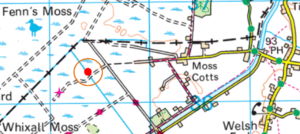The Bog Bodies of Whixall Moss
On the night of Monday 2nd September 1889 two peat-cutters, working at a depth of four feet six inches, came upon a body when one of them, Henry Slack, cut through bones beneath the knee of one leg. Together with Thomas Parsons they cleared the figure to reveal a man of about five feet eight inches of height lying out at full length and face down. Closer examination revealed some bits of flesh about the skull, breast, chest, abdomen and thighs, some hair, and a portion of what would have been a long beard. He was thought to be about 40-50 years of age and, intriguingly, he was missing both feet and a ‘cannon bone’ (?tibia) of his left leg and he was completely lacking of any clothes. His remains were lifted and placed in a coffin with transportation to the Waggoners Inn, some mile distant, to await proceedings. On the Thursday morning the Coroner, Mr Warren of Market Drayton, declined to order an inquest and so the remains were interred in Whixall churchyard the same day.

The approximate finding locations of the palstave, pink cross, the 1889 body, red spot, and the orange boundary within which the other two bodies were found.
News of this finding were reported in two newspapers – the ‘Northwich and Winsford Chronicle and the Mid-Cheshire Advertiser’ and the ‘Whitchurch Herald’ – as well as one magazine – ‘Bye gones relating to Wales and the Border Counties’. Obviously such reports produced much conversation and, from these, it was related that two further bodies had also been found.
In c1867-69 Henry Simpson and Thomas Woodward unearthed a youth, some 200 yards from where the 1889 man was found. This young man was found in a sitting position over a three-legged stool and was partly covered by a leather apron. The stool was last recorded as being in the possession of the Reverend J. Evans, vicar of Whixall. The third body, a woman, was found in c1875, by Mr. Heath and was approximately 300 yards from the 1889 body. No inquests were ordered on either of these bodies and both were thought to be interred at graveyards in Whitchurch. Unfortunately there are no records either within church papers or local newspapers in support of these findings.
As regards dates for the deaths of these individuals the more typical radiocarbon dating is less then reliable for samples taken from peaty soils. To set a date for the 1889 man stratigraphic analysis was used – where did the body sit in relation to the known age of the surrounding soils. Being found lying in the ‘black /oldest peat’ it is considered that this he is of middle Bronze Age (1500-1200 BCE). The stratigraphic positioning of the youth – higher than the 1889 man – would make him younger (dated to the Iron Age), while of the woman there is no knowledge but she is thought to be Iron Age. The Bronze Age label fits with the Middle Bronze Age bronze-looped-palstave found by George Saywell in 1927.
The discoveries of these three bodies from the moss are the most well-known. However further tails of other discoveries also exist, but with no tangible proof. For instance it has been related that navvies working on the construction of the railway line also found what they called ‘grey-bodies’. How many is unknown but the story follows the tale that they stopped reporting them as work had to cease while the authorities determined what to do about the cause of death. At one point several bodies were found in quick succession which caused the superstitious navies to take it as a sign and so many of them walked off-site, never to work on the railway line again.
Sources:
Turner R C and Penney S. 1996. Three Bog Bodies from Whixall Moss, Shropshire. Trans Shropshire Archaeol Hist Soc. Vol 71. pp.1-9.
Berry AQ, Gale F, Daniels JL, Allmark B. 1996. Fenn’s and Whixall Mosses ISBN 1 85991 023 8